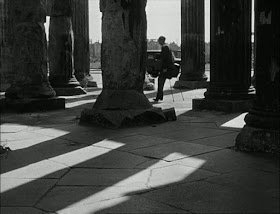I am sure there is more to it than that though, and a subject worthy of further research. The few films I have seen from those years, such as Murderers Among Us aka The Murderers Are Among Us (Wolfgang Staudte 1946), The Lost One (Peter Lorre 1951), The Devil Strikes at Night (Robert Siodmak 1957), The Bridge (Bernhard Wicki 1959) and The Thousand Eyes of Dr. Mabuse (Fritz Lang 1960) have all been striking, with the exception of The Bridge, which is strained, obvious and has one of the least convincing death scenes I have ever seen. The Bridge is also light on the question of guilt and complicity. One might get the feeling that the Germans should be pitied, being betrayed by a few evil Nazis.
Murderers Among Us
It was of course not easy to make films in Germany after the war, and filmmaking was strictly supervised by the occupying forces for a while. And the country split in half, creating two different film cultures. Of the films mentioned above Murderers Among Us was the first German film made after the war and it was produced by DEFA in the eastern half (although it had not been officially divided into an East and a West Germany yet, that happened in 1949). The others mentioned were made on the western side. Murderers Among Us is what is called a Trümmerfilm, "rubble film," as it takes place in the ruins of postwar Germany. It was its own genre almost, primarily between 1946 and 1949, and not just German-produced films. Roberto Rossellini made one contribution as well, Germany Year Zero (1948). Fred Zinnemann's fine, Swiss-produced, The Search (1948) could also be included, with Montgomery Clift in his first role (or second, depending on how you count), as a G.I. taking care of a traumatised boy, a Czech survivor of a concentration camp. Clift also starred in The Big Lift (George Seaton 1950), which was entirely shot in Berlin. Billy Wilder's A Foreign Affair (1948), with Marlene Dietrich, and Jacques Tourneur's occasionally magnificent Berlin Express (1948) were also shot in Germany, although not entirely. (Carol Reed's The Man Between (1953), while shot in Berlin, is different, and an example of a new kind of film, the Cold War thriller.)
Clift, Ivan Jandl and Zinnemann
All of the films mentioned here, except Lang's, deal with the war and its aftermath, in various ways. Siodmak's The Devil Strikes at Night is a murder history set during the war, when the police detective in charge of the investigation has to deal not only with finding the murderer but also with the Nazis, who have their own ideas of what would be politically expedient. Lorre's film The Lost One, the only film he directed, is about a doctor who is working for the Nazis during the war, and commits murder, but after the war his sense of guilt catches up with him and makes life unbearable. Murderers Among Us, which has the look and feel of Carol Reed, takes place in 1945 and is about two soldiers who meet again after the war, one consumed by guilt, the other not so much. These films were part of the national Vergangenheitsbewältigung, the effort to deal with the past.
The Devil Strikes at Night
But these are only a small portion of the films made. The German public were not immediately that interested in seeing German films but in the 1950s over 100 films a year were made in West Germany alone, and several film stars emerged then, such as Hildegard Knef, Horst Buchholz, Romy Schneider and Maximilian Schell. Many of the films made were Heimatfilme, sentimental films of the lives of ordinary, often rural, Germans. In total some 300 of them were made in the west, and two early successes were The Black Forest Girl (Hans Deppe 1950) and The Heath is Green (Hans Deppe 1951). Their engagements with Vergangenheitsbewältigung were very different than that of the other films mentioned in this post, often a case of forgetting the past rather than confronting it. But with so many as over 300 Heimatfilme there a bound to be many variations and different directions. (And the genre lives on to this day, although it did get more sour and complex along the way.) And, of course, there is more to cinema than dealing with a nation's past crimes. But I know nothing of these films artistic values, if they have any. Of other films, I am particularly eager to watch Toxi (Robert Stemmle 1952), about the racism directed towards children who have a white German mother and a black American father, and I am told the director Helmut Käutner is of significance. (He also wrote The Lost One which Peter Lorre directed.)
***
In 1948, when the Soviets instigated the blockade of Berlin (which is what The Big Lift is about) and the communists took power in a coup in Prague, Czechoslovakia, the Cold War can be said to have begun. In the end of Berlin Express the concern that former allies will now turn on each other is a lingering sentiment, and it would go downhill from there. And for German cinema fame and influence were still some years off. But, and this is my point, German cinema between 1946 and 1966 should not be forgotten or brushed off. Maybe there is a book to be written, From Knef to Merkel.
The end of Berlin Express
-----------------------------------




